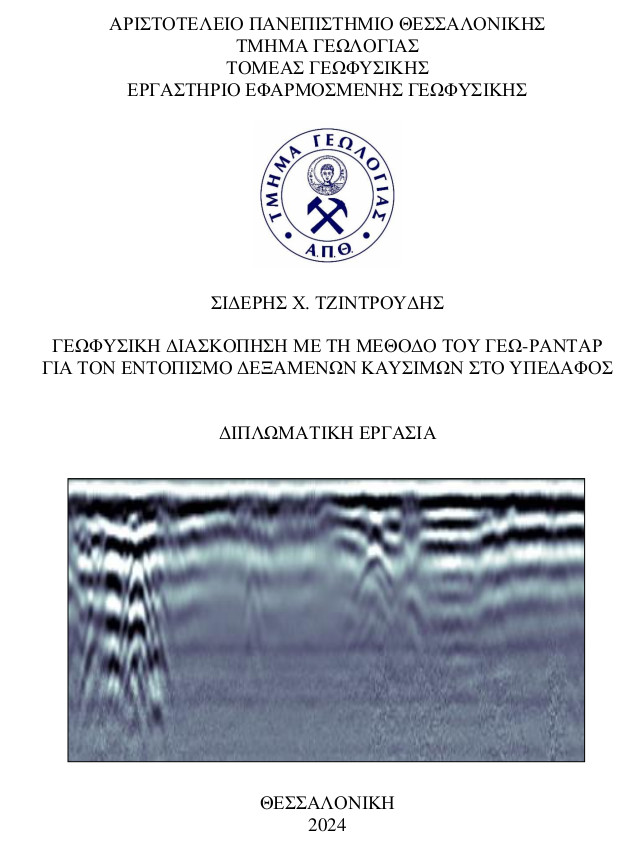
Γεωφυσική διασκόπιση με τη μέθοδο του γεοραντάρ (GPR) για τον εντοπισσμό δεξαμενών καυσίμων στο υπέδαφος = Geophysical propection using ground penetration radar to locate underground tanks.
Περίληψη
Η παρούσα πτυχιακή εργασία αποσκοπεί να αναδείξει τη σημασία χρήσης της μεθόδου του γεω-ραντάρ ή υπεδάφιου ραντάρ (Ground penetrating Radar – GPR) στον εντοπισμό και την έρευνα των υλικών του υπεδάφους αλλά και γενικότερα στην αποτελεσματικότερη μελέτη του τελευταίου. Ειδικότερα, επεξηγείται η μέθοδος GPR, τα χαρακτηριστικά και η λειτουργία του γεω-ραντάρ εξοπλισμού, καθώς και η αξιοποίηση των ιδιοτήτων των ηλεκτρομαγνητικών κυμάτων και η σημασία των ηλεκτρικών ιδιοτήτων που χαρακτηρίζουν τα υλικά του υπεδάφους για την επιτυχημένη εφαρμογή της μεθόδου. Επιπλέον, περιγράφεται αναλυτικά η έρευνα που διεξήχθη σε συγκεκριμένο χώρο με σκοπό την εύρεση μεταλλικών δεξαμενών αποθήκευσης καυσίμων. Πιο συγκεκριμένα, γίνεται αναφορά στον τρόπο διεξαγωγής της γεωφυσικής έρευνας, στη λήψη των μετρήσεων και την επεξεργασία των δεδομένων GPR. Τέλος, η εργασία καταλήγει σε ερμηνεία και παρατηρήσεις επί των αποτελεσμάτων της έρευνας στην εριοχή μελέτης.
The present thesis aims to highlight the importance of using the Ground Penetrating Radar (GPR) method for the detection and research of underground materials, as well as for the more effective study of the subsurface in general. Specifically, the structure, characteristics and operation of GPR are explained, along with the utilization of the properties of electromagnetic waves and the significance of the electrical properties of the subsurface materials for the successful application of the method. Additionally, the research conducted in a specific area is described in detail, aiming to locate underground storage tanks. In particular, reference is made to the preparatory process of the geophysical survey, the acquisition of measurements, and the processing of the acquired GPR data. Finally, the thesis concludes with an interpretation and observations on the results of the research process.
Πλήρες Κείμενο:
PDFΑναφορές
Cassidy, N. J. (2009). Electrical and Magnetic Properties of Rocks, Soils and Fluids. In H. M. Jol (Ed.), Ground Penetrating Radar Theory and Applications (pp. 41–72).
Cassidy, N. J. (2009). Chapter 5 - Ground Penetrating Radar Data Processing, Modelling and Analysis. In H. M. Jol (Ed.), Ground Penetrating Radar Theory and Applications (pp. 141–176).
Carrick Utsi, E. (2017). Chapter 1 - Fundamentals of GPR Operation. In E. Carrick Utsi (Ed.), Ground Penetrating Radar (pp. 1–11).
Carrick Utsi, E. (2017). Chapter 2 - Wavelengths and Why They Matter. In E. Carrick Utsi (Ed.), Ground Penetrating Radar (pp. 13–25).
Carrick Utsi, E. (2017). Chapter 5 - Velocity Calibration. In E. Carrick Utsi (Ed.), Ground Penetrating Radar (pp. 51–62).
Carrick Utsi, E. (2017). Chapter 8 - Data Processing. In E. Carrick Utsi (Ed.), Ground Penetrating Radar (pp. 83–92).
Annan, A. P. (2009). Electromagnetic Principles of Ground Penetrating Radar. Ground Penetrating Radar Theory and Applications (pp. 1–40).
Annan, A.P. (2003). Physical Properties I. Ground Penetrating Radar Principles, Procedures and Applications (pp. 24-41).
Kimura, W. D. (2020). What are electromagnetic waves? In Electromagnetic Waves and Lasers (Second Edition) (pp. 1-1-1–32).
Daniels, Jeffrey. (2000). Ground Penetrating Radar Fundamentals.
Plattner, A. M. (2020). GPRPy: Open-source ground-penetrating radar processing and visualization software. The Leading Edge, 39(5), 332–337.
Davis, J. L., & Annan, A. P. (1989). GROUND-PENETRATING RADAR FOR HIGH-RESOLUTION MAPPING OF SOIL AND ROCK STRATIGRAPHY1. Geophysical Prospecting, 37(5), 531–551.
Τσελέντης, Ά., & Παρασκευόπουλος, Π. (2013). ΓΕΩΡΑΝΤΑΡ, ΕΦΑΡΜΟΣΜΕΝΗ ΓΕΩΦΥΣΙΚΗ, 461-475.
Ιστοσελίδες:
Basic Principles — GPG 0.0.1 documentation. (n.d.). Ανακτήθηκε 10/07/2023
geosci.xyz ,2023: https://gpg.geosci.xyz/content/GPR/GPR_fundamental_principles.html
Εισερχόμενη Αναφορά
- Δεν υπάρχουν προς το παρόν εισερχόμενες αναφορές.
